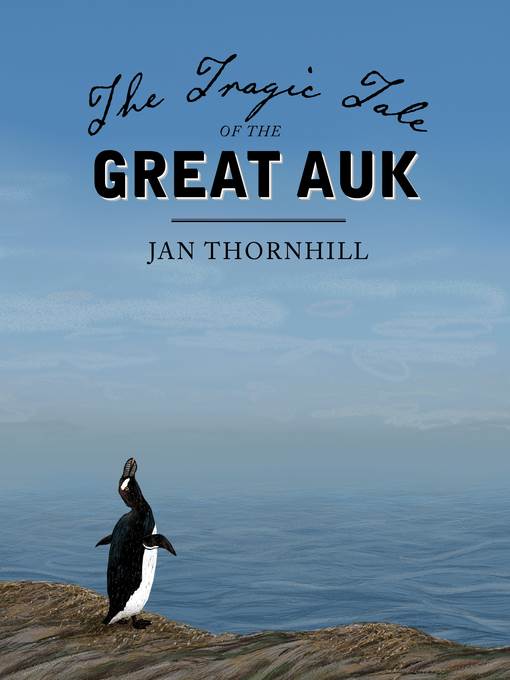
The Tragic Tale of the Great Auk
فرمت کتاب
ebook
تاریخ انتشار
2016
Lexile Score
1130
Reading Level
5
ATOS
6.5
Interest Level
4-8(MG)
نویسنده
Jan Thornhillناشر
Groundwood Books Ltdشابک
9781554988662
کتاب های مرتبط
- اطلاعات
- نقد و بررسی
- دیدگاه کاربران
نقد و بررسی

Hundreds of thousands of great auks once swam in cold northern waters, but these birds have all disappeared owing to a tragic intersection of climate change and human activities.Thornhill starts with an admirable depiction of this remarkable bird, known even to prehistoric cave painters. "Behold the Great Auk! The Gejrfugl! The northern penguin!" she begins. A tall black-and-white bird stands proudly on a rock on the facing page, looking across at a flock on another rocky island, outlined in white like ghosts. Her illustrations, done with stylus and tablet, have the look of acrylic paintings, and they are striking, with text sitting directly on the double-page illustrations. She tells this sad story smoothly and relatively gently while showing readers flocks of identifiable seabirds, schools of fish, small boats (a Viking ship, an Inuit kayak) on rough seas, the back of a fox looking down on an inaccessible island roost, a chick being fed, collections of eggs, and stuffed birds in a 19th-century museum. Many illustrations pull back to show the landscape, but some are close-ups--most effectively, a broken egg in front of the boots of the Icelandic fishermen who strangled the last two auks remaining in the world. She concludes with the legacy of this loss, part of the impetus for the bird conservation movement. A sobering, beautifully presented extinction story. (map, glossary, list of extinct species, resources, references) (Nonfiction. 9-13) COPYRIGHT(1) Kirkus Reviews, ALL RIGHTS RESERVED.

Starred review from October 1, 2016
Gr 2-5-The auk was a northern penguin that lived and thrived in the cold waters of the Atlantic. This great bird "weighed as much as a sack of potatoes and stood as tall as a three-year-old," but it had one flaw: the bird had tiny wings that were excellent for water but terrible for flying. Though it was obviously humans who pushed the auk to extinction, the how and why make this a thrilling scientific page-turner. Stunning digitally created illustrations surround the text. The images have an etched and naturalistic quality that adds beauty and an emotional connection to the story of a long-extinct animal. Prose and science come together to highlight the loss of a species and then connect this extinction with modern conservation efforts. The narrative finishes with detailed back matter that includes bird comparisons and a list of extinct animals. VERDICT An excellent addition to a library or classroom collection for read-alouds and science lessons.-Karen Ginman, BookOps: The New York Public Library and Brooklyn Public Library
Copyright 2016 School Library Journal, LLC Used with permission.

Starred review from October 1, 2016
Grades 2-5 *Starred Review* The last great auk was killed in the nineteenth century, but as this charmingly illustrated title proves, the bulky, flightless bird is far from forgotten. Thornhill begins by describing the features of the great auk that made it particularly susceptible to human predation. Since it evolved facing few land-borne predators, its stubby wings, nearly useless feet, and habit of laying eggs one at a time on bare rock were never much of a problem, but when humans arrived on the scene, with big appetites for the fatty birds and their golden-yolked eggs, the wobbly avians, so enfeebled on land, scarcely had a chance. In articulate, engaging, and even occasionally suspenseful prose, Thornhill compellingly explains the reasons the great auk is no more, gracefully combining elements of evolution, ecology, human technological advancement, and cultural trends, like the growing interest in taxidermy, while planting startling tidbits of information on every page. Her illustrations provide visual context as much as atmosphere, particularly as the stout black-and-white birds, so plentiful on rock ledges at the beginning of the book, slowly dwindle until, at the end, they're mere ghostly white outlines among flocks of nesting puffins. This vivid, fascinating story emphasizes not only the importance of conservation but also how deeply intertwined the human and animal worlds can be. Eye-opening and tragic, to be sure, but surprisingly hopeful all the same.(Reprinted with permission of Booklist, copyright 2016, American Library Association.)

























دیدگاه کاربران